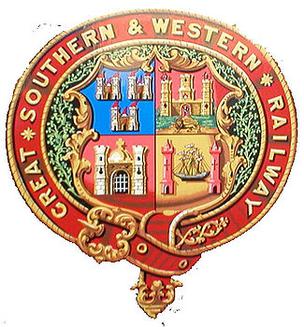Related Research Articles

County Cork is the largest and the southernmost county of Ireland, named after the city of Cork, the state's second-largest city. It is in the province of Munster and the Southern Region. Its largest market towns are Mallow, Macroom, Midleton, and Skibbereen. As of 2022, the county had a population of 584,156, making it the third-most populous county in Ireland. Cork County Council is the local authority for the county, while Cork City Council governs the city of Cork and its environs. Notable Corkonians include Michael Collins, Jack Lynch, Roy Keane, Sonia O'Sullivan, Cillian Murphy, and Graham Norton.

Rail transport in Ireland is provided by Iarnród Éireann in the Republic of Ireland and by Northern Ireland Railways in Northern Ireland.

Limerick Junction is the interchange railway station for trains originating in Limerick, Dublin Heuston, Cork, Waterford, Tralee and Ennis stations. The station opened on 3 July 1848.

Blarney Castle is a medieval stronghold in Blarney, near Cork, Ireland. Though earlier fortifications were built on the same spot, the current keep was built by the MacCarthy of Muskerry dynasty, a cadet branch of the Kings of Desmond, and dates from 1446. The Blarney Stone is among the machicolations of the castle.

Blarney is a suburban town within the administrative area of Cork City in Ireland. It is located approximately 8 kilometres (5 mi) north-west of the city centre. It is the site of Blarney Castle, home of the legendary Blarney Stone. Blarney is part of the Dáil constituency of Cork North-Central. It is surrounded by the suburban villages of Tower, Cloghroe and Kerry Pike, all on the outskirts of Cork City.

The Great Southern and Western Railway (GS&WR) was an Irish gauge railway company in Ireland from 1844 until 1924. The GS&WR grew by building lines and making a series of takeovers, until in the late 19th and early 20th centuries it was the largest of Ireland's "Big Four" railway networks. At its peak the GS&WR had an 1,100-mile (1,800 km) network, of which 240 miles (390 km) were double track.

Kilcrea Friary is a ruined medieval abbey located near Ovens, County Cork, Ireland. Both the friary and Kilcrea Castle, located in ruin to the west, were built by Observant Franciscans in the mid 15th century under the invitation of Cormac Láidir MacCarthy, Lord of Muskerry, as protection from English troops.

Cork, Bandon and South Coast Railway (CB&SCR), was an Irish gauge railway in Ireland. It opened in 1849 as the Cork and Bandon Railway (C&BR), changed its name to Cork Bandon and South Coast Railway in 1888 and became part of the Great Southern Railway (GSR) in 1924.

Kent Station is an Iarnród Éireann railway station in Cork, Ireland. Originally opened in 1893, the station operates as a hub for Intercity services to Dublin and Tralee and commuter services to Mallow, Cobh and Midleton. In 2016, Kent Station was the fifth busiest station in the Republic of Ireland, as well as the busiest outside of Dublin.

Limerick railway station also known as Colbert Station or Limerick Colbert serves the city of Limerick in County Limerick. It is on Parnell Street and is the main station on the Limerick Suburban Rail network. It has approximately 2,500 rail passengers a day travelling on four rail routes. The Bus Éireann bus station on site services approximately one million passengers a year, with 125 buses departing each day.

Cork is the second largest city in the Republic of Ireland, third largest on the island of Ireland, and largest in the province of Munster. At the 2022 census, it had a population of 222,526.
Events from the year 1542 in Ireland.

Farran is a village in County Cork, Ireland, in the parish of Ovens. It lies on the southside of the River Lee. Farran is 12 miles (19 km) west from Cork City on the N22 road.
Cormac Laidir MacCarthy, 9th Lord of Muskerry (1411–1494), was an Irish chieftain. He founded Kilcrea Friary and built Kilcrea Castle.
Saint Ciera of Ireland was an abbess in the 7th century who died in 679. Her history is probably commingled with another Cera who lived in the 6th century. However, some authors maintain that monastic mistakes account for references to Cera in the 6th century or that a single Cera had an exceptionally long life span.

The MacCarthy dynasty of Muskerry is a tacksman branch of the MacCarthy Mor dynasty, the Kings of Desmond.

Cork Albert Quay railway station was on the Cork, Bandon and South Coast Railway in County Cork, Ireland.

Kilcrea Castle is a ruined 15th-century towerhouse and bawn located near the Kilcrea Friary, west of Cork City, Ireland. The tower house and friary were both built by Cormac Laidir MacCarthy, 9th Lord of Muskerry.

Cormac Oge Laidir MacCarthy, 10th Lord of Muskerry (1447–1536) was an Irish chieftain, styled Lord of Muskerry. In 1520 he defeated James FitzGerald, 10th Earl of Desmond in the battle of Mourne Abbey.
References
- ↑ "Kilcrea station" (PDF). Railscot - Irish Railways. Retrieved 7 May 2012.